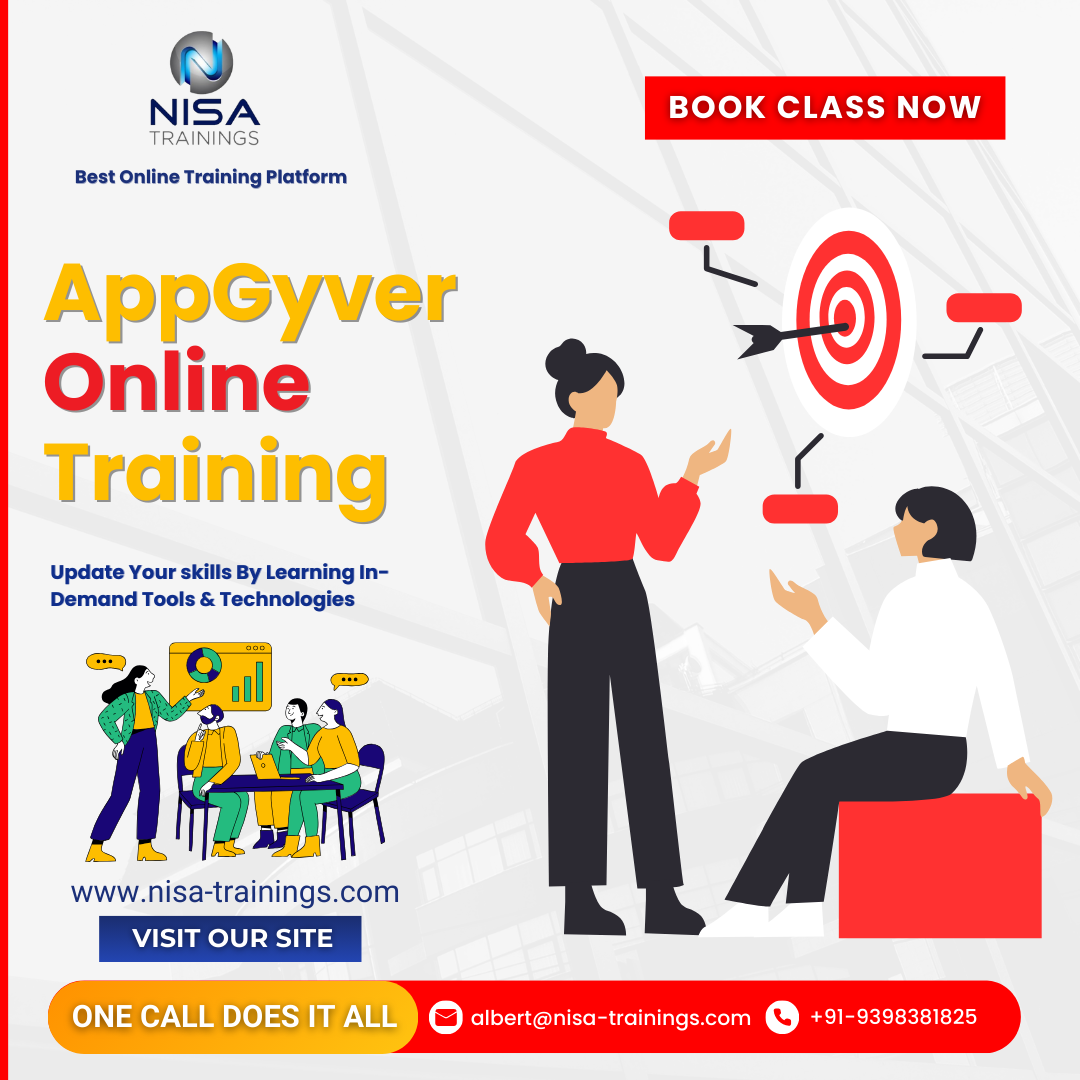AppGyver Training
AppGyver is a no-code platform designed for building web and mobile applications quickly and efficiently. Training on AppGyver typically covers a range of topics aimed at empowering users to create fully functional apps without needing extensive coding knowledge.

Why should you choose Nisa For AppGyver Training?
Nisa Trainings is the best online training platform for conducting one-on-one interactive live sessions with a 1:1 student-teacher ratio. You can gain hands-on experience by working on near-real-time projects under the guidance of our experienced faculty. We support you even after the completion of the course and happy to clarify your doubts anytime. Our teaching style at Nisa Trainings is entirely hands-on. You’ll have access to our desktop screen and will be actively conducting hands-on labs on your desktop.
Job Assistance
If you face any problem while working on AppGyver Course, then Nisa Trainings is simply a Call/Text/Email away to assist you. We offer Online Job Support for professionals to assist them and to solve their problems in real-time.
The Process we follow for our Online Job Support Service:
- We receive your inquiry for Online Job
- We will arrange a telephone call with our consultant to grasp your complete requirement and the tools you’re
- If our consultant is 100% confident in taking up your requirement and when you are also comfortable with our consultant, we will only agree to provide service. And then you have to make the payment to get the service from
- We will fix the timing for Online Job Support as mutually agreed by you and our consultant.
Course Information
AppGyver Training
Duration: 25 Hours
Timings: Weekdays (1-2 Hours per day) [OR] Weekends (2-3 Hours per day)
Training Method: Instructor Led Online One-on-One Live Interactive
Sessions.
COURSE CONTENT :
Module 1: Introduction to AppGyver
- What is AppGyver?
- Overview of no-code platforms.
- Key features of AppGyver.
- Understanding the AppGyver Studio interface.
- Setting Up an Account and Project
- Creating an AppGyver account.
- Navigating the AppGyver workspace.
- Starting a new project and exploring templates.
Module 2: Building User Interfaces (UI)
- UI Components and Layouts
- Drag-and-drop interface design.
- Common UI components: buttons, text, images, forms, inputs, etc.
- Layout options: containers, grids, flexbox.
- Styling and Customization
- Customizing component styles (color, typography, size, etc.).
- Using themes and custom CSS for advanced styling.
- Responsive Design
- Creating layouts that work on multiple screen sizes.
- Previewing and adjusting for mobile, tablet, and desktop views.
Module 3: Adding Logic and Workflows
- Understanding Logic Components
- Introduction to the Logic Editor.
- Adding actions and events (e.g., on button click).
- Working with conditions and loops.
- Data Binding and Conditional Logic
- Binding data to UI elements (e.g., showing dynamic content).
- Using formulas and expressions in logic.
- Handling User Interactions
- Implementing form submissions, user input, and navigation between pages.
- Triggering workflows based on user actions.
Module 4: Data Integration
- Connecting to Data Sources
- Setting up data models (collections, fields, etc.).
- Connecting to external REST APIs and databases.
- Working with AppGyver’s Data Resource
- Creating, reading, updating, and deleting data (CRUD operations).
- Binding data to UI components for real-time display.
- Advanced Data Operations
- Filtering, sorting, and paginating data.
- Handling user authentication and access control.
Module 5: Working with APIs and External Integrations
- Integrating External APIs
- How to connect your app to third-party services via REST APIs.
- Using API data in your app’s UI and logic.
- Custom JavaScript Functions (Optional)
- Implementing custom logic with JavaScript (if needed).
- Advanced integration options using JavaScript for specific use cases.
Module 6: Testing and Debugging
- Previewing Your App
- Using the AppGyver Preview app to test your app on mobile devices.
- Debugging issues using the browser-based preview mode.
- Error Handling and Debugging Logic
- Identifying and resolving common issues in workflows and data bindings.
- Using the AppGyver Debugger for troubleshooting.
- User Testing and Feedback
- Conducting usability tests and gathering feedback.
- Making iterative improvements based on user input.
Module 7: Publishing and Deployment
- Preparing for App Publishing
- Preparing assets and metadata for app submission.
- Creating app icons, splash screens, and optimizing performance.
- Publishing to Web, iOS, and Android
- Exporting apps for web deployment.
- Creating app builds for Android (APK) and iOS (IPA).
- Publishing to Google Play and the Apple App Store.
- App Updates and Version Management
- Managing and versioning your app for future updates.
- Updating your app on different platforms after changes.
Module 8: App Maintenance and Best Practices
- App Monitoring and Analytics
- Integrating app analytics for tracking usage and performance.
- Monitoring app errors and crashes using AppGyver’s built-in tools.
- Scalability and Performance Optimization
- Optimizing the app for speed and scalability.
- Best practices for managing large amounts of data and traffic.
- User Support and Documentation
- Creating user guides and in-app support.
- Providing ongoing maintenance and bug fixes.
Module 9: Advanced Topics (Optional)
- Custom Plugins and Extensions
- Introduction to creating custom AppGyver plugins.
- Adding advanced functionality through AppGyver’s extensibility options.
- Push Notifications and Background Tasks
- Setting up push notifications for iOS and Android apps.
- Scheduling background tasks to run at specific times.
